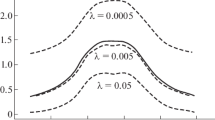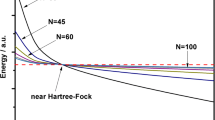Abstract
When considering quantum systems in phase space, the Wigner function is used as a function of quasi-probability density. Finding the Wigner function is related to the calculation of a Fourier transform of a certain composition of wave functions of the corresponding quantum system. As a rule, knowledge of the Wigner function is not the final goal, and the calculation of mean values of different quantum characteristics of the system is required. An explicit solution of the Schrödinger equation can be obtained only for a narrow class of potentials, therefore, in the majority of cases, numerical methods must be used to find wave functions. As a result, finding the Wigner function is related to the numerical integration of grid wave functions. When considering a one-dimensional system, the calculation of N2 Fourier integrals of the grid wave function is needed. To provide the necessary accuracy for wave functions, corresponding to the higher states of a quantum system, a larger number of grid nodes is needed. The goal of this work was to construct the numerical-analytical method for finding the Wigner function, which allows the number of computational operations to be considerably reduced. The quantum systems with polynomial potentials were considered, for which the Wigner function is represented as a series in some known functions.














Similar content being viewed by others
REFERENCES
E. P. Wigner, “On the quantum correction for thermodynamic equilibrium,” Phys. Rev. 40, 749–759 (1932).
H. Weyl, The Theory of Groups and Quantum Mechanics (Dover, New York, 1931).
Causality Problems in Quantum Mechanics. Collection of Translations, Ed. by Ya. P. Terletsky and A. A. Gusev (IL, Moscow, 1955).
N. L. Balazs and B. K. Jennings, “Wigner’s functions and other distribution functions in mock phase spaces,” Phys. Rep. 104, 347–391 (1984).
M. Hillery, R. F. O’Connell, M. O. Scully, and E. P. Wigner, “Distribution functions in physics: Fundamentals,” Phys. Rep. 106, 121–167 (1984).
B.-G. Englert, “On the operator bases underlying Wigner’s, Kirkwood’s and Glauber’s phase space functions,” J. Phys. A 22, 625–640 (1989).
I. Bialynicki-Birula, M. Cieplak, and J. Kaminski, Theory of Quanta (Oxford University Press, 1992).
A. M. Ozorio de Almeida, “The Weyl representation in classical and quantum mechanics,” Phys. Rep. 295, 265–342 (1998).
E. Scheibe, Die Reduktion physikalischer Theorien, Teil II (Springer, Heidelberg, 1999).
Y. Kano, “A new phase-space distribution function in the statistical theory of the electromagnetic field,” J. Math. Phys. 6, 1913–1915 (1965).
R. J. Glauber, “Photon correlations,” Phys. Rev. Lett. 10, 84–86 (1963).
E. C. G. Sudarshan, “Equivalence of semiclassical and quantum mechanical descriptions of statistical light beams,” Phys. Rev. Lett. 10, 277–279 (1963).
K. E. Cahill and R. J. Glauber, “Density operators and quasiprobability distributions,” Phys. Rev. A 177, 1882–1902 (1969).
H. J. Groenewold, “On the principles of elementary quantum mechanics,” Physica 12, 405–460 (1946).
G. S. Agarwal and E. Wolf, “Calculus for functions of noncommuting operators and general phase-space methods in quantum mechanics. II. Quantum mechanics in phase space,” Phys. Rev. D 2, 2187–2205 (1970).
Valentino A. Simpao, “Real wavefunction from generalised Hamiltonian Schrodinger equation in quantum phase space via HOA (Heaviside Operational Ansatz): Exact analytical results,” J. Math. Chem. 52, 1137–1155 (2014).
D. B. Fairliet and C. A. Manoguei, “The formulation of quantum mechanics in terms of phase space functions—the third equation,” J. Phys. A: Math. Gen. 24, 3807–3815 (1991).
K. B. Møller, T. G. Jørgensen, and G. Torres-Vega, “On coherent-state representations of quantum mechanics: Wave mechanics in phase space,” J. Chem. Phys. 106, 7228–7240 (1997).
D. T. Smithey, M. Beck, M. G. Raymer, and A. Faridani, “Measurement of the Wigner distribution and the density matrix of a light mode using optical homodyne tomography: Application to squeezed states and the vacuum,” Phys. Rev. Lett. 70, 1244–1247 (1993).
J. Radon, “Fiber die Bestimmung von Funktionen durch ihre Integralwerte Langs gewisser Mannigfaltigkeiten,” Ber. Verh. Sachs. Akad. Wiss. Leipzig, Math.-Nat. Kl. 69, 262–277 (1917).
G. M. D’Ariano, M. G. A. Paris, and M.F. Sacchi, “Quantum tomography,” in Advances in Imaging and Electron Physics, Ed. by P.W. Hawkes (Elsevier, 2003), Vol. 128, pp. 205–308.
K. Vogel and H. Risken, “Determination of quasiprobability distributions in terms of probability distributions for the rotated quadrature phase,” Phys. Rev. A 40, 2847–2849 (1989).
A. Casado, S. Guerra, and J. Plácido, “From stochastic optics to the Wigner formalism: The role of the vacuum field in optical quantum communication experiments,” Atoms 7, 76 (2019).
A. Casado, S. Guerra, and J. Plácido, “Wigner representation for experiments on quantum cryptography using two-photon polarization entanglement produced in parametric down-conversion,” J. Phys. B 41, 045501 (2008).
R. P. Rundle, T. Tilma, J. H. Samson, V. M. Dwyer, R.F. Bishop, and M. J. Everitt, “General approach to quantum mechanics as a statistical theory,” Phys. Rev. A 99, 012115 (2019).
I. I. Arkhipov, A. Barasiński, and J. Svozilík, “Negativity volume of the generalized Wigner function as an entanglement witness for hybrid bipartite states,” Sci. Rep. 8, 16955 (2018).
U. Andersen, J. Neergaard-Nielsen, P. van Loock, et al., “Hybrid discrete- and continuous-variable quantum information,” Nature Physics 11, 713–719 (2015).
L. Cohen, Time-Frequency Analysis (Prentice Hall, Englewood Cliffs, 1995).
A. Zayed, “A new perspective on the two-dimensional fractional Fourier transform and its relationship with the Wigner distribution,” J. Fourier. Anal. Appl. 25, 460–487 (2019).
T. A. C. M. Claasen and W. F. G. Mecklenbräuker, “The Wigner distribution—a tool for time-frequency signal analysis. II: Discrete-time signals, part 2,” Philips J. Res. 35, 276–300 (1980).
D. Brandon, N. Saad, and Shi-Hai Dong, “On some polynomial potentials in d-dimensions,” J. Math. Phys. 54, 082106 (2013).
F. J. Gomez and J. Sesma, “Quantum anharmonic oscillators: A new approach,” J. Phys. A 38, 3193–3202 (2005).
F. Pan, J. R. Klauder, and J. P. Draayer, “Quasi-exactly solvable cases of an N-dimensional symmetric decatic anharmonic oscillator,” Phys. Lett. A 262, 131 (1999).
M. Bansal, S. Srivastava, and Vishwamittar, “Energy eigenvalues of double-well oscillator with mixed quartic and sextic anharmonicities,” Phys. Rev. A 44, 8012 (1991).
R. N. Chaudhuri and M. Mondal, “Improved Hill determinant method: General approach to the solution of quantum anharmonic oscillators,” Phys. Rev. A 43, 3241 (1991).
R. L. Hall and N. Saad, “Bounds on Schrodinger eigenvalues for polynomial potentials in N-dimensions,” J. Math. Phys. 38, 4909 (1997).
M. Vishwarmittar, “Energy eigenvalues for anharmonic and double-well oscillators with even power polynomial potential,” Physica A 216, 452–458 (1995).
E. Z. Liverts and V. B. Mandelzweig, “Approximate analytic solutions of the Schrodinger equation for the generalized anharmonic oscillator,” Phys. Scr. 77, 025003 (2008).
E. E. Perepelkin, B. I. Sadovnikov, N. G. Inozemtseva, and E. V. Burlakov, “Wigner function of a quantum system with polynomial potential,” J. Stat. Mech. Theory Exp. 2020. 053105 (2020).
B. V. Numerov, “Note on the numerical integration of \({{{{d}^{2}}x} \mathord{\left/ {\vphantom {{{{d}^{2}}x} {d{{t}^{2}}}}} \right. \kern-0em} {d{{t}^{2}}}} = f\left( {x,t} \right)\),” Astronomische Nachrichten 230, 359–364 (1927).
E. E. Perepelkin, B. I. Sadovnikov, N. G. Inozemtseva, and E. V. Burlakov, “Explicit form for the kernel operator matrix elements in eigenfunction basis of harmonic oscillator,” J. Stat. Mech. Theory Exp. 2020, 023109 (2020).
B. I. Sadovnikov, N. G. Inozemtseva, and E. E. Perepelkin, “Generalized phase space and conservative systems,” Doklady Mathematics 88, 457–459 (2013).
E. E. Perepelkin, B. I. Sadovnikov, and N. G. Inozemtseva, Generalized Phase Space (Faculty of Physics, MSU, Moscow, 2014), 164 p.
B. I. Sadovnikov, E. E. Perepelkin, and N. G. Inozemtseva, “Coordinate uncertainty principle in a generalized phase space,” Doklady Mathematics 90, 628–630 (2014).
E. E. Perepelkin, B. I. Sadovnikov, and N. G. Inozemtseva, “The quantum mechanics of high-order kinematic values,” Ann. Phys. 401, 59–90 (2019).
E. E. Perepelkin, B. I. Sadovnikov, and N. G. Inozemtseva, “The new modified Vlasov equation for the systems with dissipative processes,” J. Stat. Mech. Theory Exp. 2017, 053207 (2017).
A. A. Vlasov, The Theory of Many Particles (URSS, Moscow, 2011) [In Russian].
A. A. Vlasov, Statistical Distribution Functions (Nauka, Moscow, 1966) [In Russian].
E. E. Perepelkin, B. I. Sadovnikov, and N.G. Inozemtseva, “The properties of the first equation of the Vlasov chain of equations,” J. Stat. Mech. Theory Exp. 2015, 05019 (2015).
E. E. Perepelkin, B. I. Sadovnikov, and N. G. Inozemtseva, “Paradigm of Infinite Dimensional Phase Space,” in Understanding the Schrödinger Equation: Some [Non]Linear Perspectives (Nova Science Publishers, Inc., United States, 2020), pp. 248–288.
D. Bohm, “A suggested interpretation of the quantum theory in terms of “hidden” variables I and II," Phys. Rev. 85, 166–193 (1952).
D. Bohm, B. J. Hiley, and P. N. Kaloyerou, “An ontological basis for the quantum theory,” Phys. Rep. 144, 321–375 (1987).
D. Bohm and B. J. Hiley, The Undivided Universe: An Ontological Interpretation of Quantum Theory (Routledge, London, 1993).
L. de Broglie, Une Interprétation Causale et non Linéaire de la Mécanique Ondulatoire: La Théorie de la Double Solution (Gauthiers-Villiars, Paris, 1956).
W. P. Schleich, Quantum Optics in Phase Space (Wiley-VCH, Berlin, 2001) 718 p.
Hudson R.L. “When is the Wigner quasi-probability density non-negative?,” Rep. Math. Phys. 6, 240–252 (1974).
K. Husimi, “Some formal properties of the density matrix,” Proc. Phys. Math. Soc. Jpn. 22, 264–314 (1940).
Y. Kano, “A new phase-space distribution function in the statistical theory of the electromagnetic field,” J. Math. Phys. 6, 1913–1915 (1965).
R. J. Glauber, “Photon correlations,” Phys. Rev. Lett. 10, 84–86 (1963).
E. C. G. Sudarshan, “Equivalence of semiclassical and quantum mechanical descriptions of statistical light beams,” Phys. Rev. Lett. 10, 277–279 (1963).
K. E. Cahill and R. J. Glauber, “Density operators and quasiprobability distributions,” Phys. Rev. A 177, 1882–1902 (1969).
Go. Torres-Vega and J. H. Frederick, “A quantum mechanical representation in phase space,” J. Chem. Phys. 98, 3103–3120 (1993).
Go. Torres-Vega and J. H. Frederick, “Quantum mechanics in phase space: New approaches to the correspondence principle,” J. Chem. Phys. 93, 8862–8874 (1990).
N. Wiener “Hermitian polynomials and Fourier analysis,” J. Math. Phys. 8, 70–73 (1929).
W. Koepf, “Identities for families of orthogonal polynomials and special functions,” Integral Transforms and Special Functions 5, 69–102 (1997).
W. A. Al-Salam, “Operational representations for Laguerre and other polynomials,” Duke Math. J. 31, 127–142 (1964).
E. E. Perepelkin, B. I. Sadovnikov, and N. G. Inozemtseva, “Riemann surface and quantization,” arXiv: 1606.02013v1 (2016).
A. N. Kolmogorov and S. V. Fomin, Elements of the Theory of Functions and Functional Analysis (Nauka, Moscow, 1976; Dover Publ., 1999).
Funding
This work was supported by the Russian Foundation for Basic Research (grant No. 18-29-10014).
This research has been supported by the Interdisciplinary Scientific and Educational School of Moscow University “Photonic and Quantum Technologies. Digital Medicine.”
Author information
Authors and Affiliations
Corresponding authors
Additional information
Translated by M. Samokhina
Rights and permissions
About this article
Cite this article
Perepelkin, E.E., Sadovnikov, B.I., Inozemtseva, N.G. et al. An Efficient Numerical Algorithm for Constructing the Wigner Function of a Quantum System with a Polynomial Potential in Phase Space. Phys. Part. Nuclei 52, 438–476 (2021). https://doi.org/10.1134/S1063779621030072
Received:
Revised:
Accepted:
Published:
Issue Date:
DOI: https://doi.org/10.1134/S1063779621030072




